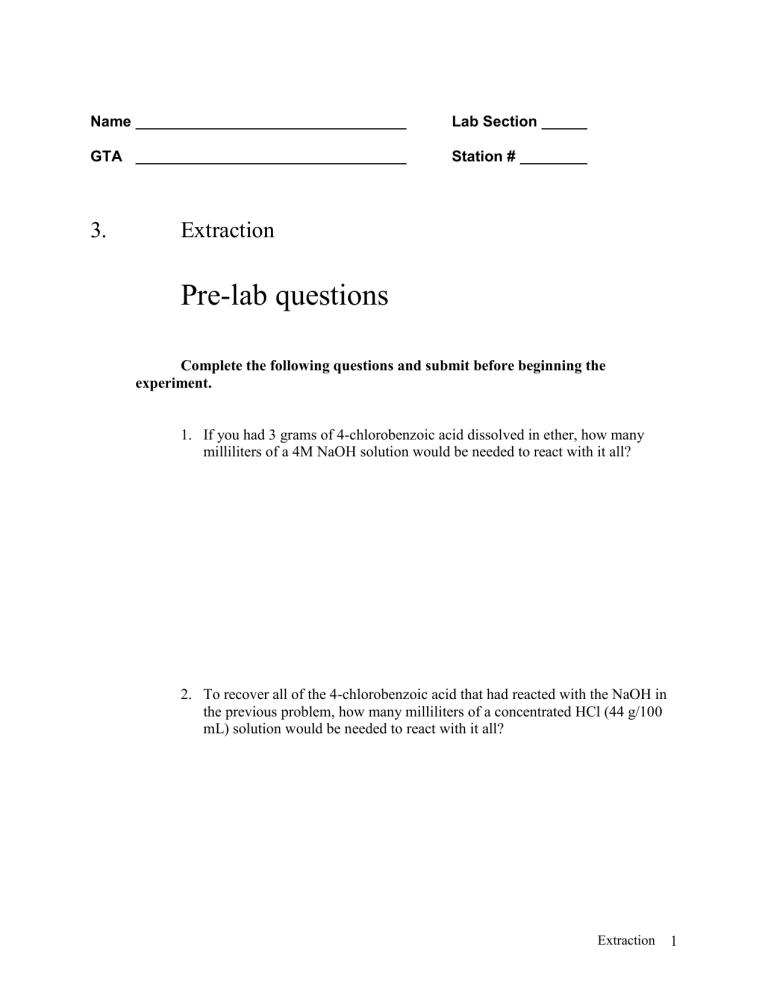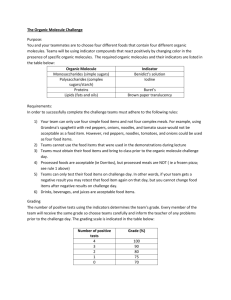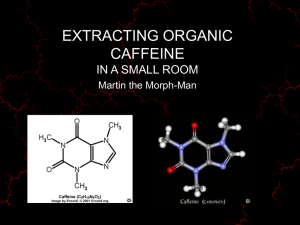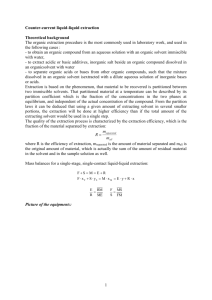Handout Extraction

Name
GTA
3. Extraction
Pre-lab questions
Lab Section
Station #
Complete the following questions and submit before beginning the experiment.
1.
If you had 3 grams of 4-chlorobenzoic acid dissolved in ether, how many milliliters of a 4M NaOH solution would be needed to react with it all?
2.
To recover all of the 4-chlorobenzoic acid that had reacted with the NaOH in the previous problem, how many milliliters of a concentrated HCl (44 g/100 mL) solution would be needed to react with it all?
Extraction 1
3.
The partition coefficient of benzoic acid is 3 in methylene chloride with respect to water. If 6 grams of benzoic acid was dissolved into 600 mL of water, how much benzoic acid can be extracted with four 150 mL portions of methylene chloride?
4.
Using Schemes 1 and 2 in your handout as references, fill in the flowchart on the following page for the separation of an organic acid (R-COOH), a base (R-
NH
2
) and a neutral organic compound.
Pre-lab Notebook preparation
Prepare the following in your lab notebook before beginning the experiment.
1.
Start a new page by entering the title of this experiment.
2.
Start a section with the subtitle
“
Part 1 - Procedure
”
and provide an outline of the experimental procedure to be carried out. Do the same for Part 2.
Extraction 2
R-COOH + ne utr al or gan ic + R-NH
2
Extraction 3
3. Extraction
Zubrick:
Vocabulary: another to
Chapters 15 and 16
127-130 (general introduction)
133-136 (how to extract, sample extraction, washing)
138-139 (extraction hints)
141-143 (microscale extraction information)
Miscible Two or more compounds which dissolve in one form a homogenous solution
Aqueous
Organic contains water non-aqueous (does not contain water), usually hydrophobic
Emulsion No separation of the organic and aqueous layers
(usually cloudy).
Partition coefficient The same as the distribution coefficient. It is the relationship between the solubility ratios of two different layers for a compound which is soluble in both solvents.
This procedure has been adapted from the microscale procedure described in M acroscale and Microscale
Organic Chemistry Experiments by Kenneth L. Williamson.
Background
What is extraction? There are several listings for extraction in the
American Heritage Dictionary (p. 466) but in its simplest form, extraction is the separation of something from another. There are numerous examples in our everyday lives. Vanilla extract is used in cooking. The essence of perfume is extracted from flowers, plants, etc. For the organic
Extraction 4
chemist, extraction is part of the normal work up of a reaction.
Sometimes, it is referred to as aqueous workup in the text or manuscript.
We wash the organic reaction mixture with water (acidic, neutral and/or basic) to remove any byproducts or inorganic material.
There are three basic types of extraction: liquid/liquid, acid/base and solid/liquid. We will be performing the first two types of extraction in this experiment. First, we have to understand how to choose a solvent for extraction. A couple of things we have to consider are polarity and density of the solvent. The polarity of the solvent is important because
“like dissolves like.” So if the extraction is from an aqueous solution, we do not want a solvent that is miscible with water. Thus during the extraction two layers are formed, aqueous and organic. It is important to know the density of the solvent so that we can predict which one is the organic layer. Most chlorinated solvents have densities greater than water
(>1 g/mL). Aromatic (toluene, benzene - any compound which contains a benzene ring), aliphatic compounds (hexanes), and ethers have densities less than one. They would float on the top of the water layer. When in doubt, add a drop of water and observe which layer it joins.
Sometimes we run into compounds which are soluble in organic as well as aqueous solvents. Such compounds partition between layers of these solvents placed in contact with each other. A measure of this equilibrium is the partition or distribution coefficient, k, which is defined for a compound (A), a pair of solvents (including water (W) and a solvent (S)), and a certain temperature. It can be calculated as follows (where C stands for concentration): k = C
A in S
C
A in W
This relation can be approximated with (where Sol is the solubility in g/100mL): k = Sol
A in S
Sol
A in W
For example, compound A has a solubility of 6 g/ 100 mL in diethyl ether and a solubility of 3 g/ 100 mL in water, therefore k is equal to k = 6 g/100 mL
3 g/100 mL = 2
Let’s assume that you have prepared a solution of 3 g of A in 100 mL of water and then extracted (washed) the water layer with 100 mL of diethyl ether. How much material remains in the water layer? Let x be the grams of A in the ether layer. Then:
Extraction 5
k = 2 = x g /100 mL ether
(3 - x ) g /100 mL water
2(3 - x ) = x
6 - 2x = x
6 = 3 x x = 2
3 - x = 3 - 2 = 1 g (which is the mass of A left in the water layer)
Now, let’s assume that the extraction was carried out with two 50 mL portions of diethyl ether instead of a single 100 mL portion. The calculation is in two steps: k = 2 = x g /50 mL ether
(3 - x ) g /100 mL water
2(3 - x ) = 2 x
3 - x =
3 = 2 x x x = 1.5 g
3 - x = 3 - 1.5 = 1.5 g (which is lthe mass of A left in the water layer)
For the next aliquot of 50 mL: k = 2 = x g /50 mL ether
(1.5 - x ) g /100 mL water
2(1.5 -
1.5 - x
1.5 = 2 x
= x
) = 2 x x x = 0.75 g
1.5 - x = 1.5 – 0.75 = 0.75 g (which is the mass of A left in the water layer)
It is clear that multiple extractions are more efficient than single extractions. When working up a reaction, organic chemists usually extract/wash three times.
Another typical extraction is acid/base. A Brønsted acid is a proton (H +
) donor; whereas a Brønsted base is a proton (H +
) acceptor. Let's consider the separation of a strong organic acid, an organic base, and a neutral organic compound. From general chemistry you know about strong and weak mineral acids, but in organic chemistry we consider carboxylic acids as strong organic acids. These carboxylic acids have p K a s in the range from 1.83-6.0. Remember there is a tenfold increase in acidity for every p K a
unit.
Extraction 6
CH
2
Cl
2 dichloromethane
(met hy lene chloride)
MW 84.93 bp 40 o
C d 1.325
CO OH benz oic ac id
C
7
H
6
O
2
MW 122. 12 mp 122-123 o
C p K a
= 4. 19
H
3
C
H
3
C
CH
3
CH
3
1, 2,4,5-tet ramethy l benz ene (durene)
C
10
H
14
MW 134. 22 mp 80-82 o
C
CH
3
CH
2
-O-CH
2
CH diet hy lether (ether)
3
MW 74.12 bp 34. 6 o
C d 0.708
NH
2
Cl
4-c hloroaniline
( p -chloroaniline)
C
6
H
6
NCl MW 127.57 mp 168-71 o
C p K b
= 4. 15
NaO H sodium hy droxide
MW 40.00
(CH
3
)
3
C-O-C(CH
3
)
3 ditert -buty lether
(buty l ether) MW 130.23 bp 142-143 o
C d 0.764
HCl hydroc hloric ac id
FW 36.46
Extraction 7
Extraction of a strong organic acid from a neutral organic compound
(Scheme 1)
The separation of benzoic acid from 1,2,4,5-tetramethylbenzene is depicted in Scheme 1.
CO OH benz oic ac id
+
H
3
C CH
3
H
3
C CH
3
1, 3,5-trimethylbenz ene st ep 1
CH
2
Cl
2 dichloromethane st ep 2
NaO H
3M sodium hydrox ide st ep 3
CO O
-
Na
+ sodium benz oate
H
3
C CH
3
H
3
C CH
3
1, 3,5-trimethylbenz ene st ep 4 st ep 5
HCl hydroc hloric ac id
CO OH st ep 6 benz oic ac id
The first step is to dissolve the two compounds in an organic solvent like dichloromethane (CH
2
Cl
2
). Diethyl ether is also used but the densities of the two different organic solvents are different. The densities of chlorinated hydrocarbons are greater than that of water (d > 1 g/mL), whereas the densities of ethers are less than that of water (d < 1 g/mL).
Extraction 8
In the second step, a base, sodium hydroxide solution, is added to the solution. Since benzoic acid is a "strong" organic acid, a weak base, such as sodium bicarbonate, can also be used. To insure that the organic acid is completely transferred into the aqueous layer, this layer is tested using pH paper. A drop of the aqueous layer is dropped onto a piece of pH paper until the paper tests positive for base. It is important to mix the solution after each addition of base.
There are two layers formed upon addition of the basic solution to the organic solution, because the organic solvent (CH
2
Cl
2
) is not miscible in the basic aqueous layer. In step three, the different layers are separated from one another. Since CH
2
Cl
2
is denser than the aqueous layer, this layer is removed and treated further in steps five and six.
In step four, the organic layer containing the compound (1,2,4,5tetramethylbenzene) is dried using calcium chloride pellets. Any time an organic layer is washed or touches water, it must be dried using a drying agent. The solvent is then removed with a pipette to another tube and isolated after removal of CH
2
Cl
2
via evaporation with heat.
In step five, the sodium benzoate is neutralized and acidified (protonated) to regenerate benzoic acid, which precipitates from the aqueous solution.
The pH of the solution is tested with pH paper.
In step six, the benzoic acid can be isolated by vacuum filtration.
Extraction 9
Extraction of an organic base from a neutral organic compound
(Scheme 2)
The separation of 4-chloroaniline from 1,2,4,5-tetramethylbenzene is depicted in Scheme 2.
NH
2
Cl
4-c hloroaniline
+
H
3
C CH
3
H
3
C CH
3
1, 3,5-trimethylbenz ene st ep 1
CH
2
Cl
2 dichloromethane st ep 2 st ep 3
NH
3
+
Cl
-
Cl
4-c hloroaniline hy drochloride
HCl hy drochloric acid
H
3
C CH
3
H
3
C CH
3
1, 3,5-trimethylbenz ene st ep 4 st ep 5
NaO H sodium hy droxide st ep 6
NH
2
Cl
4-c hloroaniline
Extraction 10
The first step is to dissolve the two compounds in an organic solvent like dichloromethane (CH
2
Cl
2
). Diethyl ether is also used but the densities of the two different organic solvents are different. The densities of chlorinated hydrocarbons are greater than that of water (d > 1), whereas the densities of ethers are less than that of water (d < 1).
In the second step, an acid, hydrochloric acid, is added to the solution. To insure that the organic base is completely transferred into the aqueous layer, this layer is tested using pH paper. A drop of the aqueous layer is dropped onto a piece of pH paper until the paper tests positive for acid. It is important to mix the solution after each addition of acid.
There are two layers formed upon addition of the basic solution to the organic solution, because the organic solvent (CH
2
Cl
2
) is not miscible in the acidic aqueous layer. In step three, the different layers are separated from one another. Since CH
2
Cl
2
is higher in density than the aqueous layer, this layer is removed and treated further in steps five and six.
In step four, the organic layer containing the compound (1,2,4,5tetramethylbenzene) is dried using calcium chloride pellets. The solvent is then removed with a pipette to another tube and isolated after removal of
CH
2
Cl
2
via evaporation with heat.
In step five, the 4-chloroaniline hydrochloride is neutralized
(deprotonated) to regenerate organic base, which precipitates from the aqueous solution. The pH of the solution is tested with pH paper.
In step six, the 4-chloroaniline can be isolated by vacuum filtration.
Experiment
A. Partition Coefficient of an Organic Acid
Weigh approximately 0.25 g of the unknown and place into a small reaction tube. Dissolve the solid in exactly 3 mL of dichloromethane.
Add exactly 6 mL of water, cap the tube and shake. Let the mixture stand until two layers form. Remove the aqueous layer. Add calcium chloride pellets to the organic layer. Remove the dichloromethane with a pipette and filter through a funnel plugged with cotton into a pre-weighed 50 mL beaker including a boiling chip . Wash the pellets with a full pipette of dichloromethane. Remove the dichloromethane with a pipette and filter through the funnel plugged with cotton into the 50 mL beaker. Evaporate
Extraction 11
off the dichloromethane in the hood on a hot plate under low heat. When the beaker has cooled to room temperature, weigh the beaker.
B. Multiple Extractions of an Organic Acid
Weigh approximately 0.25 g of the unknown and transfer it into a small reaction tube. Dissolve the solid in exactly 3 mL of dichloromethane.
Add exactly 2 mL of water, cap the tube and shake. Let the mixture stand until two layers are formed. Remove the aqueous layer. Wash the organic layer two more times with exactly 2 mL of water (each time). After the final wash, dry the organic layer with calcium chloride pellets. Remove the dichloromethane with a pipette and filter through a funnel plugged with cotton into a pre-weighed 50 mL beaker including a boiling chip .
Wash the pellets with a full pipette of dichloromethane. Remove the dichloromethane with a pipette and filter through the funnel plugged with cotton into the 50 mL beaker. Evaporate off the dichloromethane in the hood on a hot plate under low heat. When the beaker has cooled to room temperature, weigh the beaker.
C. Extraction of an Organic Acid with a Basic Solution
Weigh approximately 0.25 g of the unknown and transfer the unknown into a small reaction tube. Dissolve the solid in exactly 3 mL of dichloromethane. Add exactly 2 mL of a saturated sodium bicarbonate solution, cap the tube and shake. Let the mixture stand until two layers are formed. Remove the aqueous layer. Wash the organic layer twice more with exactly 2 mL of a saturated sodium bicarbonate solution. After the final wash, dry the organic layer with calcium chloride pellets. Remove the dichloromethane with a pipette and filter through a funnel plugged with cotton into a pre-weighed 50 mL beaker including a boiling chip .
Wash the pellets with a full pipette of dichloromethane. Remove the dichloromethane with a pipette and filter through the funnel plugged with cotton into the 50 mL beaker. Evaporate off the dichloromethane in the hood on a hot plate under low heat. When the beaker has cooled to room temperature, weigh the beaker.
Extraction 12
D. Separation of an Organic Acid, a Phenol and a Neutral Substance
Before you begin the experiment, label your four small reaction tubes 1, 2, and 3 respectively.
D1.
To tube 1 add all of your unknown solution. Rinse out your vial with dichloromethane and place the rinse into tube 1 . Add 1 mL of a sodium bicarbonate solution. Cap the tube and shake to mix the phases.
After the mixture has settled, you should have two layers. Remove the aqueous layer and place it into tube 2 . Wash tube 1 once more with 1 mL of the sodium bicarbonate solution, removing the aqueous layer and placing it into tube 2 . Test the pH of tube 2. Is it basic? If not, keep washing tube 1 with 1 mL portions of sodium bicarbonate until the pH of tube 2 is basic. When tube 2 has the correct pH, add 1 mL of dichloromethane to tube 2 , cap and shake. Remove the organic layer from tube 2 and discard.
D2. To tube 2 add concentrated HCl dropwise. As you add HCl, precipitate should be forming. When precipitate seems to not be forming any more, test the pH. Is it acidic? If not, keep adding HCl until it is.
Filter the contents of tube 2 , and recrystallize in water.
D3. To tube 1 add 1 mL of a NaOH solution. . Cap the tube and shake to mix the phases. After the mixture has settled, you should have two layers. Remove the aqueous layer and place it into tube 3 . Wash tube 1 once more with 1 mL of the NaOH solution, removing the aqueous layer and placing it into tube 3 . Test the pH of tube 3. Is it basic? If not, keep washing tube 1 with 1 mL portions of NaOH until the pH of tube 3 is basic. When tube 3 has the correct pH, add 1 mL of dichloromethane to tube 3 , cap and shake. Remove the organic layer from tube 3 and discard.
D4. To tube 3 add concentrated HCl dropwise. As you add HCl precipitate should be forming. When precipitate seems to not be forming any more, test the pH. Is it acidic? If not, keep adding HCl until it is.
Filter the contents of tube 3 , and recrystallize in water.
D5. To tube 1 add 1 mL of a saturated NaCl solution. Cap the tube and shake to mix the phases. After the mixture has settled, you should have two layers. Remove the aqueous layer and discard it. To tube 1 add calcium chloride pellets. When the solvent is deemed dry, remove the organic layer with a pipette and filter through a funnel with a cotton plug into a 50 mL beaker. Wash the pellets twice more with pipettes full of dichloromethane, each time removing with a pipette and filtering through a funnel with a cotton plug into the 50 mL beaker. Add a boiling chip to the beaker and evaporate the solvent off in the hood on a hot plate with low heat. Recrystallize the solid in ethanol.
Extraction 13
D5
Tube 1, organic layer
Carboxilic Acid;
Phenol; Neutral
D1
Tube 2, aqueous layer
Phenol; Neutral Sodium Carboxylate
D3
Tube 1, organic layer
Neutral
Tube 3, aqueous layer
Sodium Phenolate
D4
D2
Neutral Phenol Carboxylic Acid
Extraction 14
Name
GTA
3. Extraction
Post-lab questions
A.
Total mass of sample
Lab Section
Station #
A.
Recovered mass of sample in organic layer
A.
Mass of sample in aqueous layer
A.
Partition coefficient ( k )
A.
% recovery
Show the calculations for your partition coefficient.
B.
Total mass of sample
B.
Recovered mass of sample in organic layer
B.
Mass of sample in aqueous layer
B.
% recovery
Show the calculations for your % mass recovery.
Extraction 15
Using the partition coefficient that you calculated in Part A, calculate the theoretical amount of recovered organic acid for Part B. Compare your theoretical recovery to actual recovery of benzoic acid.
C.
Total mass of sample
C.
Recovered mass of sample in organic layer
C.
Mass of sample in aqueous layer
C.
% recovery
Show the calculations for your % recovery.
Which part of the experiment (A, B, or C) was most efficient for the extraction of organic acid? Explain why.
D.
Recovered mass of carboxylic acid
D.
Recovered mass of phenol
D.
Recovered mass of neutral substance
D.
Identification of phenol (attach IR spectrum)
What was your mass % composition of acid : phenol : neutral?
Extraction 16






